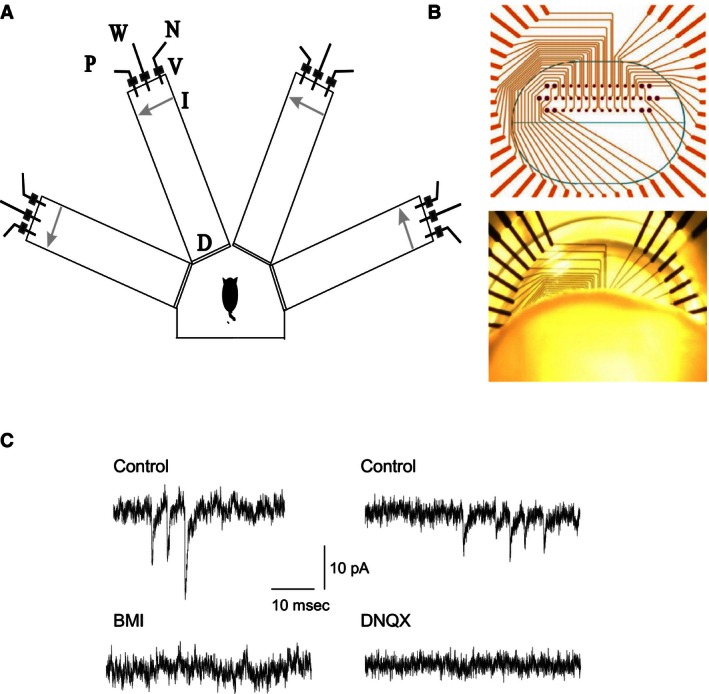Figure 1.

Training and elecrophysiological recordings. (A) Schematic representation of the olfactory maze. Protocols for “trained” and “pseudotrained” rats were similar: an electronic “start” command randomly opened two of eight valves (V), releasing pressured air streams with positive cue odor (P) into one of the arms and negative‐cue odor (N) into another. Eight seconds later, the two corresponding guillotine doors (D) were lifted to allow the rat to enter the selected arms. Upon reaching the far end of an arm (90 cm long), the rat's body interrupted an infrared beam (I, arrow) and a drop of drinking water was released from a water hose (W) into a small drinking well. For a “trained” rat, this occurred only if the arm contained the positive cue odor; for a “pseudotrained” rat, it occurred randomly. A trial ended when the rat interrupted a beam, or after 10 sec if no beam was interrupted. A fan operated for 15 sec between trials, to remove odors. Each rat underwent 20 trials per day. (B) Placement of piriform cortex slices on microelectrodes arrays (MEAs). Top: Thirty‐two recording electrodes (small dots) are arranged in three rows, with distance of 90 mm between electrodes on the same row and 150 mm between electrodes on the same column. Twelve stimulating electrodes (large dots) surround the recording electrodes. Bottom: a coronal piriform cortex slice mounted on a MEA. Schematic layer topography of the piriform cortex is shown. Slices were positioned on the MEA such that cell bodies layers (Layer II) were aligned with the bottom row of MEA recording electrodes. This positioning allowed recording of signals from layer Ib proximal dendrites via the second row of electrodes and signals from more distal dendrites via the first row of electrodes. (C) Recordings of spontaneous miniature postsynaptic currents. Left: Miniature inhibitory synaptic events recorded from a neuron at a holding potential of −60 mV. Excitatory synaptic activity was abolished by the specific GABAA receptor blocker, bicuculline. Right: Miniature excitatory synaptic events recorded from a neuron at a holding potential of ‐80 mV. Inhibitory synaptic activity was abolished by the specific AMPA receptor blocker, DNQX.
